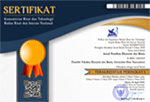Foreign Portfolio Investment Control Using Macroeconomic and Institutional Policies: Evidence from Indonesia and Thailand
DOI:
https://doi.org/10.33633/jpeb.v6i2.4446Abstract
This study analyzed the influence of macroeconomic and institutional variables on foreign portfolio investment inflows in two ASEAN countries, Namely Indonesia and Thailand, in 2005 – 2019. The analytical tools used in this research are Panel Vector Error Correction Model (PVECM) and Panel Ordinary Least Square (POLS). The estimation results show that the macroeconomic variables that are proxied using inflation and openness economy and institutional variables that are proxied using the variable level of corruption and quality of regulation have a significant effect. In the long term, the inflation rate, the openness economy, and the quality of regulation variables significantly affect foreign portfolio investment. Meanwhile, in a short time, only the inflation rate variable and the openness ratio have a significant effect on foreign portfolio investment. The two analytical tools used found that macroeconomic and institutional variables consistently affect foreign portfolio investment.Keywords: Foreign portfolio investment, Inflation, Openness Economy ratio, CorruptionRegulation, PVECM, POLSReferences
Al-Smadi, M. O. (2018). Determinants of foreign portfolio investment: The case of Jordan. Investment Management and Financial Innovations, 15(1), 328–336. https://doi.org/10.21511/imfi.15(1).2018.27
Arltová, M., & Fedorová, D. (2016). Selection of unit root test on the basis of length of the time series and value of AR(1) parameter. Statistika, 96(3), 47–64.
Calvo, G. A., Leiderman, L., & Reinhart, C. M. (1996). Inflows of Capital to Developing Countries in the 1990s. Journal of Economic Perspectives, 10(2), 123–139. https://doi.org/10.1257/jep.10.2.123
Cheung, Y. W., & La, K. S. (1995). Lag order and critical values of the augmented dickey-fuller test. Journal of Business and Economic Statistics, 13(3), 277–280. https://doi.org/10.1080/07350015.1995.10524601
Fernandez-Arias, E. (1996). The new wave of private capital inflows: Push or pull? Journal of Development Economics, 48(2), 389–418. https://doi.org/10.1016/0304-3878(95)00041-0
Fernandez-Arias, E. (2000). The New Wave of Capital Inflows?: Sea Change or Just Another Tide?? Development, 1–48.
Ibrahim, M. H. (2000). Cointegration and Granger Causality Tests of Stock Price and Exchange Rate Interactions in Malaysia. Asean Economic Bulletin, 17(1), 36–47. https://doi.org/10.1355/ae17-1d
Liew, V. K. (2006). Which Lag Length Selection Criteria Should We Employ. Economics Bulletin, 3(33), 1–9.
Lütkepohl, H. (2004). Vector autoregressive and vector error correction models. In Applied Time Series Econometrics (pp. 86–158). https://doi.org/10.1017/CBO9780511606885.004
Mu’min, M. S., Anggara, Y. P., & Maulana, R. B. (2018). IDENTIFIED OF TOBACCO INDUSTRY DEVELOPMENT IN EAST JAVA: ERROR CORRECTION MODEL APPROACH AND THE TRIPLED LAYER BUSINESS CANVAS MODEL APPLICATION. Journal of Developing Economies, 3(2), 53. https://doi.org/10.20473/jde.v3i2.10782
OECD. (2016). Open Government in Indonesia. In Far Eastern Survey (Vol. 16, Issue 4).
Pesaran, M. H., Shin, Y., & Smith, R. J. (2000). Structural analysis of vector error correction models with exogenous I(1) variables. Journal of Econometrics, 97(2), 293–343. https://doi.org/10.1016/S0304-4076(99)00073-1
Purna, F. P., Mulyo, P. P., & Bima, M. R. A. (2016). EXCHANGE RATE FLUCTUATION IN INDONESIA: VECTOR ERROR CORRECTION MODEL APPROACH. Jurnal Ekonomi & Studi Pembangunan, 17(2). https://doi.org/10.18196/jesp.17.2.3955
Rahim, M., Adam, P., Suriadi, L. O., Saenong, Z., Atmodjo, E., Rumbia, W. A., & Tamburaka, I. P. (2018). Causal relationship between electric consumption and economic growth in south east Sulawesi. International Journal of Energy Economics and Policy, 8(6), 29–34. https://doi.org/10.32479/ijeep.6973
Silatchom, F. D. P. (2017). VECM and Variance Decomposition: An Application to the Consumption-Wealth Ratio. International Journal of Economics and Finance, 9(6), 188. https://doi.org/10.5539/ijef.v9n6p188
Sinay, L. J. (2014). PENDEKATAN VECTOR ERROR CORRECTION MODEL UNTUK ANALISIS HUBUNGAN INFLASI, BI RATE DAN KURS DOLAR AMERIKA SERIKAT. BAREKENG: Jurnal Ilmu Matematika Dan Terapan, 8(2), 9–18. https://doi.org/10.30598/barekengvol8iss2pp9-18
Steyn, H. S. (2002). Practically significant relationships between two variables. SA Journal of Industrial Psychology, 28(3). https://doi.org/10.4102/sajip.v28i3.63
Transparency International Indonesia. (2016). Survei Persepsi Korupsi 2015. Riset, 1.
Ul Haque, N., Mathieson, D., & Sharma, S. (1997). Causes of capital inflows and policy responses to them. Finance and Development, 34(1), 3–6.
Umutlu, M., Akdeniz, L., & Altay-Salih, A. (2010). The degree of financial liberalization and aggregated stock-return volatility in emerging markets. Journal of Banking and Finance, 34(3), 509–521. https://doi.org/10.1016/j.jbankfin.2009.08.010
Warsono, Russel, E., Wamiliana, Widiarti, & Usman, M. (2019). Vector autoregressive with exogenous variable model and its application in modeling and forecasting energy data: Case study of PTBA and HRUM energy. International Journal of Energy Economics and Policy, 9(2), 390–398. https://doi.org/10.32479/ijeep.7223
World Economic Forum. (2016). The Global Risks Report 2016 | World Economic Forum. Journal of Sustainable Finance & Investment, 1(3), 81–87.
Zou, X. (2018). VECM Model Analysis of Carbon Emissions, GDP, and International Crude Oil Prices. Discrete Dynamics in Nature and Society, 2018. https://doi.org/10.1155/2018/5350308
Downloads
Published
How to Cite
Issue
Section
License
The copyright of the received article shall be assigned to the journal as the publisher of the journal. The intended copyright includes the right to publish the article in various forms (including reprints). The journal maintains the publishing rights to the published articles.
This work is licensed under a Creative Commons Attribution 4.0 International License.


.png)









